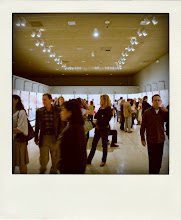 Here’s a story about one of the “new” works on view in the recently reinstalled European Art gallery at the Museum.
Here’s a story about one of the “new” works on view in the recently reinstalled European Art gallery at the Museum.

A few months ago, one of our registrars came to my office and handed me a quick index photograph (there it is at left) she’d just taken of a work that turned up during an inventory of one of the store rooms. The work, attributed to Rosalba Carriera, was acquired in 1949 but no one could recall ever having seen it on public view.
My first thought:
Wow. That looks like the real thing.
Rosalba Carriera was one of the most highly-sought portraitists in eighteenth-century Italy, second in popularity only to Pompeo Batoni (whose portrait of Etienne-Reneé Potier de Gesvres hangs in the recently reinstalled gallery). Rosalba’s particular specialty was the portrait in pastels, and she had few equals in that medium. The portrait of a woman had all the benchmarks of her style, and having been little-exhibited, it seemed – even in the photograph – remarkably fresh. Rosalba is a special artist; the Getty has
just acquired a pastel portrait by her.
But then I had my second thought:
Oh no. The Frame.
The frame is unmistakably that of the royal collection in Dresden. Once you’ve seen a group of them, you can’t miss them. And the problem with the frame was that at the outbreak of World War II, the Dresden collections were dispersed for safekeeping, and many works never made it back to the museum when the war ended. The Dresden Museum has a major
provenance research project underway in an effort to locate all the looted treasures.
Born and trained in Italy, Rosalba had spent years working at the court in Dresden, and the largest collection of her pastel portraits is in the museum there. This seemed to be a vote in favor of the San Diego portrait’s authenticity. The bad news, though, is that I was afraid that just as we’d rediscovered a great work, we might have to send it back to Dresden.
So let the research begin: I quickly discovered in our curatorial files that the dealer who sold us the work wrote in 1948 that he got it through an “exchange with the Dresden Museum, about 18 years ago.” (The dealer was Jacob Heimann, of New York and Los Angeles – and if anyone has more information about him, please let me know). I’ll admit I was deeply skeptical.
I went back to the old catalogues of the Dresden collection. The 1899 and 1905 catalogues list 156 pastels, but only 109 are in the catalogues published since 1929, with no reference to the missing 47.
At this point, I wrote to Andreas Henning, the Curator in Dresden. I explained that I was doing “a bit of research on Rosalba, and that I was curious about the pastels missing from later editions of their catalogue.” (This was a bit evasive, I’ll admit it.) Andreas explained that yes, some of the Rosalba pastels had been missing since before the war, but earlier in the century, Dresden’s then-director Hans Posse “exchanged” some with dealers in an attempt to acquire contemporary art.
We then went through the old catalogue lists, and we found one pastel described as a
“Portrait nearly front view, dark grey background. Brown eyes; flowers in the gray hair; brown, multicolored flowered dress with a décolletée. The right hand at the breast.” This seemed to match. It was number 88 in the old catalogue, and it had been sold back in 1924 in exchange of a painting by Wilhelm Trübner.
At this point, I went back into storage and opened up the frame. There, on the back of the old stretcher supporting the pastel, was a most welcome sight: the number
88. Case closed. Not only had we confirmed its provenance, we’d also established that it had been sold by Dresden, and that we would not have to send it back.
And it’s now on the wall in San Diego, for the first time in decades. But pastels are delicate, and after a few months, we’ll return it to a nice dark corner of the storeroom to preserve it.
Come see it while you have the chance.
John Marciari
Curator of European Art
Head of Provenance Research















































